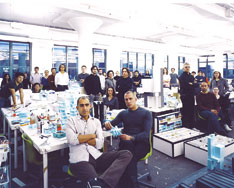 Jason Schmidt Prince-Ramus (front, right) at REX’s helm, with his partner Ella (front, left).
|
After six years running OMA New York, architect Joshua Prince-Ramus felt it was time to cut the umbilical cord with his largely absentee partner-mentor, Rem Koolhaas.
OMA NY, formed in 2000, was owned by Koolhaas and Prince-Ramus. “Our office became an aberration within OMA,” says Prince-Ramus, who cut his teeth on OMA’s unorthodox Seattle Central Library. “There were six partners in the [Rotterdam-based Office of Metropol-itan Architecture] and me in New York,” he says.
Prince-Ramus maintains that Koolhaas’s reputation was keeping OMA NY from getting work. “If you want Rem, why would you go to New York?” he asks, adding that when Koolhaas didn’t show for something, clients would feel slighted.
In 2004, OMA NY landed its first job without Koolhaas—a theater in Dallas. Once OMA NY started working autonomously, Prince-Ramus says the only thing holding the offices together were his relationship and the office’s relationship with Koolhaas. Legally, the two firms were separate entities.
So, on May 14, 2006, Prince-Ramus and his new partner, Erez Ella, bought out Koolhaas and formed REX, retaining the OMA NY work. Prince-Ramus, 37 years old, had spent 10 years with OMA. Ella, 36 years old, had been with OMA for six years. The partners say it was a break without animosity. REX now numbers 55 people.
Atypical
REX has an atypical philosophy: to design collaborations rather than dictate solutions and to side with neither form nor function. REX says it also “loves” the banal and views constraints as possibilities.
The owner of REX’s most ambitious job to date, the 1.6-million-sq-ft Museum Plaza development in Louisville, Ky., never wanted Koolhaas. “We hired Joshua and Erez,” says Craig Greenberg, one of the four members of Museum Plaza LLC. “It was a nonissue when they split with OMA.”

Post a comment to this article
Report Abusive Comment